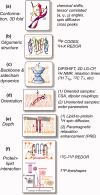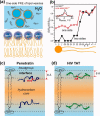Structure and dynamics of cationic membrane peptides and proteins: insights from solid-state NMR
- PMID: 21344534
- PMCID: PMC3081543
- DOI: 10.1002/pro.600
Structure and dynamics of cationic membrane peptides and proteins: insights from solid-state NMR
Abstract
Many membrane peptides and protein domains contain functionally important cationic Arg and Lys residues, whose insertion into the hydrophobic interior of the lipid bilayer encounters significant energy barriers. To understand how these cationic molecules overcome the free energy barrier to insert into the lipid membrane, we have used solid-state NMR spectroscopy to determine the membrane-bound topology of these peptides. A versatile array of solid-state NMR experiments now readily yields the conformation, dynamics, orientation, depth of insertion, and site-specific protein-lipid interactions of these molecules. We summarize key findings of several Arg-rich membrane peptides, including β-sheet antimicrobial peptides, unstructured cell-penetrating peptides, and the voltage-sensing helix of voltage-gated potassium channels. Our results indicate the central role of guanidinium-phosphate and guanidinium-water interactions in dictating the structural topology of these cationic molecules in the lipid membrane, which in turn account for the mechanisms of this functionally diverse class of membrane peptides.
Copyright © 2011 The Protein Society.
Figures






Similar articles
-
Phosphate-mediated arginine insertion into lipid membranes and pore formation by a cationic membrane peptide from solid-state NMR.J Am Chem Soc. 2007 Sep 19;129(37):11438-46. doi: 10.1021/ja072511s. Epub 2007 Aug 18. J Am Chem Soc. 2007. PMID: 17705480
-
Orientation of a beta-hairpin antimicrobial peptide in lipid bilayers from two-dimensional dipolar chemical-shift correlation NMR.Biophys J. 2006 May 15;90(10):3616-24. doi: 10.1529/biophysj.105.062075. Epub 2006 Feb 24. Biophys J. 2006. PMID: 16500957 Free PMC article.
-
Structure, topology, and dynamics of membrane peptides and proteins from solid-state NMR spectroscopy.J Phys Chem B. 2007 Sep 6;111(35):10340-51. doi: 10.1021/jp073652j. Epub 2007 Aug 9. J Phys Chem B. 2007. PMID: 17685648 Review.
-
The membrane-bound structure and topology of a human α-defensin indicate a dimer pore mechanism for membrane disruption.Biochemistry. 2010 Nov 16;49(45):9770-82. doi: 10.1021/bi101512j. Epub 2010 Oct 26. Biochemistry. 2010. PMID: 20961099 Free PMC article.
-
Structure and mechanism of beta-hairpin antimicrobial peptides in lipid bilayers from solid-state NMR spectroscopy.Mol Biosyst. 2009 Apr;5(4):317-22. doi: 10.1039/b820398a. Epub 2009 Jan 27. Mol Biosyst. 2009. PMID: 19396367 Free PMC article. Review.
Cited by
-
NMR analyses of the interaction between the FYVE domain of early endosome antigen 1 (EEA1) and phosphoinositide embedded in a lipid bilayer.J Biol Chem. 2012 Oct 12;287(42):34936-34945. doi: 10.1074/jbc.M112.398255. Epub 2012 Aug 22. J Biol Chem. 2012. PMID: 22915584 Free PMC article.
-
Magic-angle-spinning NMR techniques for measuring long-range distances in biological macromolecules.Acc Chem Res. 2013 Sep 17;46(9):2154-63. doi: 10.1021/ar300294x. Epub 2013 Feb 7. Acc Chem Res. 2013. PMID: 23387532 Free PMC article.
-
The Antimicrobial and Antiviral Applications of Cell-Penetrating Peptides.Methods Mol Biol. 2015;1324:223-45. doi: 10.1007/978-1-4939-2806-4_15. Methods Mol Biol. 2015. PMID: 26202273 Free PMC article. Review.
-
Antimicrobial peptide ROAD-1 triggers phase change in local membrane environment to execute its activity.J Mol Model. 2019 Aug 29;25(9):281. doi: 10.1007/s00894-019-4163-8. J Mol Model. 2019. PMID: 31468141
-
Effects of human antimicrobial cryptides identified in apolipoprotein B depend on specific features of bacterial strains.Sci Rep. 2019 Apr 30;9(1):6728. doi: 10.1038/s41598-019-43063-3. Sci Rep. 2019. PMID: 31040323 Free PMC article.
References
-
- Zasloff M. Antimicrobial peptides of multicellular organisms. Nature. 2002;415:389–395. - PubMed
-
- Fischer R, Fotin-Mleczek M, Hufnagel H, Brock R. Break on through to the other side-biophysics and cell biology shed light on cell-penetrating peptides. ChemBioChem. 2005;6:2126–2142. - PubMed
-
- Jiang Y, Lee A, Chen J, Ruta V, Cadene M, Chait BT, MacKinnon R. X-ray structure of a voltage-dependent K+ channel. Nature. 2003;423:33–41. - PubMed
-
- Hessa T, Kim H, Bihlmaier K, Lundin C, Boekel J, Andersson H, Nilsson I, White SH, von Heijne G. Recognition of transmembrane helices by the endoplasmic reticulum translocon. Nature. 2005;433:377–381. - PubMed
-
- Popot JL, Engelman DM. Membrane protein folding and oligomerization: the two-stage model. Biochemistry. 1990;29:4031–4037. - PubMed
MeSH terms
Substances
Grants and funding
LinkOut - more resources
Full Text Sources

